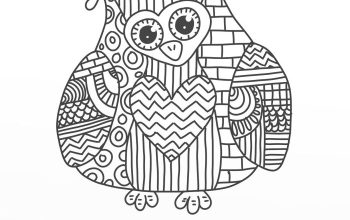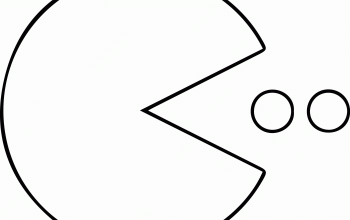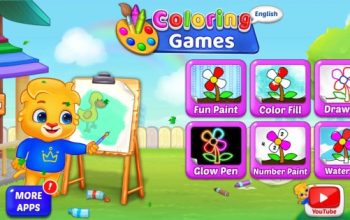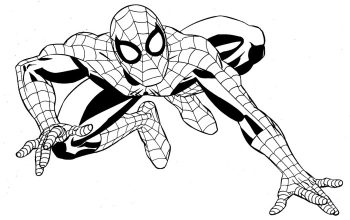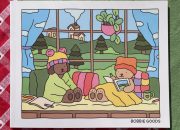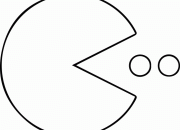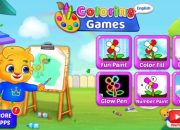Barn Coloring Page Designs
Barn coloring book pages – This section details five unique barn coloring page designs, catering to different skill levels and artistic preferences. Each design incorporates varying levels of complexity, detail, and stylistic approaches to provide a diverse range of options for coloring enthusiasts. The designs are intended to be engaging and fun for a wide age range.
Barn Coloring Page Design Descriptions and Comparison
The following table summarizes the key features of five distinct barn coloring page designs. These designs range from simple Artikels suitable for young children to more intricate designs appealing to older children and adults.
| Design Name | Line Thickness | Detail Level | Overall Style |
|---|---|---|---|
| Simple Barn | Thick | Low | Cartoonish |
| Detailed Barn with Animals | Medium | High | Realistic |
| Cartoon Barn with Farm Friends | Thin to Medium | Medium | Cartoonish |
| Rustic Barn with Floral Accents | Medium | Medium-High | Realistic with Stylized Elements |
| Geometric Barn | Medium-Thick | Low to Medium | Abstract |
Simple Barn: This design features a basic rectangular barn shape with a simple triangular roof. Thick lines make it easy for young children (ages 3-5) to color within the lines. The design could include a single, large door and a few simple windows. It emphasizes large, easily colored areas.
Detailed Barn with Animals: This design presents a more realistic barn with intricate details such as wood planks, a weathered texture, and possibly a silo. Animals like cows, chickens, or horses could be included in the surrounding area, adding complexity and visual interest. This design is suitable for older children (ages 8-12) and adults who enjoy detailed coloring.
Cartoon Barn with Farm Friends: This design incorporates a fun, cartoonish style. The barn itself would have exaggerated features, perhaps with smiling windows and a friendly-looking door. Cute farm animals, like pigs with curly tails or sheep with oversized eyes, would be incorporated in a playful manner. This design is suitable for children of all ages, particularly those who appreciate whimsical imagery (ages 5-10).
Rustic Barn with Floral Accents: This design combines realistic elements with stylized details. The barn would be depicted in a rustic style, with visible wood grain and perhaps some wear and tear. Floral elements, such as climbing roses or wildflowers, could be incorporated around the barn, adding a touch of elegance and visual appeal. This design is appropriate for older children and adults who enjoy a blend of realism and artistic expression (ages 10+).
Geometric Barn: This design uses geometric shapes to represent the barn. Instead of traditional lines, the barn is constructed from triangles, squares, and other geometric forms, creating an abstract and visually interesting design. This design would be suitable for children and adults who enjoy abstract art and exploring different creative styles (ages 8+).
Barn Coloring Page Themes

Exploring diverse themes for barn coloring pages allows for a wide range of creative expression and caters to different age groups and interests. By offering varied themes, we can engage a broader audience and stimulate imaginative coloring experiences.This section details three distinct themes suitable for barn-themed coloring pages: a traditional farm scene, a whimsical fairytale setting, and a modern minimalist design.
Each theme includes a suggested color palette and examples of elements that could be incorporated into the design.
Traditional Farm Scene
This theme evokes a classic, nostalgic feeling, ideal for younger children or those who appreciate traditional imagery. The color palette should be warm and earthy, focusing on natural tones.A suitable color palette would include various shades of brown (for the barn wood, fences, and ground), greens (for fields and trees), and yellows (for hay bales and sunlit areas). Accents of red could be used for farm equipment or a farmer’s attire.Elements that could be included are: a red barn with a weathered wooden texture, rolling green hills, various farm animals such as cows, pigs, chickens, and horses, hay bales, farming equipment (tractors, plows), and perhaps a farmer tending to the animals or crops.
The overall scene should depict a peaceful, idyllic farm setting.
Whimsical Fairytale Setting, Barn coloring book pages
This theme offers a more fantastical and playful approach, perfect for children with active imaginations. The color palette should be brighter and more vibrant, incorporating magical and enchanting hues.A vibrant color palette could include pastel shades of pink, purple, and blue, along with bright greens and yellows. Metallic gold and silver could add a touch of fantasy.Elements that could be included are: a barn transformed into a magical dwelling, perhaps with twinkling lights or vines growing up the sides, friendly fairytale creatures like fairies, gnomes, or unicorns, whimsical flowers and plants, enchanted trees, and a starry night sky.
The overall scene should feel magical and enchanting.
Modern Minimalist Design
This theme provides a clean and contemporary aesthetic, appealing to older children and adults who appreciate simplicity. The color palette should be limited, using a small selection of colors in a balanced and harmonious way.A sophisticated color palette could include muted shades of grey, beige, and white, with a single accent color such as a deep blue or a soft green.Elements that could be included are: a geometrically-shaped barn, simple lines and shapes, a limited number of objects (perhaps a single tree or a few carefully placed hay bales), and a focus on negative space.
The overall effect should be clean, modern, and visually appealing.
Simple Barn Coloring Page Incorporating All Three Themes
Imagine a single barn structure as the central focus. One side of the barn could reflect the traditional farm scene with a rustic wooden texture, a few hay bales, and a small cow peeking out from behind. Another side could showcase the fairytale theme with pastel-colored vines growing up the walls and a small, friendly gnome sitting near the entrance.
Finally, the roof could incorporate the minimalist design with clean lines and a muted grey color. This design allows for the incorporation of all three themes within a single cohesive image, providing a rich and varied coloring experience.
Barn coloring book pages offer a charmingly rustic theme, perfect for those seeking a peaceful coloring experience. For a slightly darker, more whimsical alternative, consider the spooky charm of nightmare before christmas coloring book ; its intricate designs offer a fascinating contrast. Returning to the tranquility of the barn, these pages provide a welcome change of pace with their simpler imagery.
Coloring Page Layout and Composition: Barn Coloring Book Pages

Effective layout and composition are crucial for creating engaging and visually appealing barn coloring pages. A well-planned design guides the coloring process, encouraging creativity and preventing a cluttered or overwhelming experience for the user. Careful consideration of elements like negative space and the arrangement of key features ensures a balanced and aesthetically pleasing final product.A sample layout for a barn coloring page could feature a large central barn, taking up roughly 40% of the page.
This barn could be detailed, showing doors, windows, and perhaps even a hayloft. To the left of the barn, a group of farm animals—cows, chickens, or pigs—could occupy about 25% of the page. These animals should be realistically proportioned relative to the barn. The remaining 35% of the page to the right of the barn could depict a simple landscape, including rolling hills, trees, and perhaps a sun or moon in the sky.
This creates a natural flow and context for the barn and animals.
Effective Use of Negative Space
Negative space, or the area around the main elements of a design, is just as important as the elements themselves. In a barn coloring page, effective use of negative space creates visual breathing room and prevents the design from feeling cramped. For example, leaving ample white space around the barn and animals allows them to stand out and prevents visual clutter.
Strategic use of negative space can also guide the eye, creating a natural visual pathway through the design. A well-placed patch of white space can draw the eye to a specific detail, like a small window on the barn or a playful piglet. Conversely, clustering animals closer together in a small area creates a contrast against the negative space surrounding the barn.
This technique can be used to highlight the barn as the dominant feature of the page.
Sample Coloring Page Layout Using a Three-Column Table
The following describes a coloring page layout utilizing a responsive three-column table. Imagine this table adapting to different screen sizes, maintaining its proportional layout.
| Column 1: This column would feature a detailed barn drawing, occupying most of the vertical space. The barn could include intricate details such as roof shingles, window panes, and a weathered wooden door. Consider incorporating small decorative elements, such as flowers or climbing vines, to add visual interest without overwhelming the main subject. | Column 2: This column features a group of farm animals. The animals are placed closer together to create a focal point, contrasting with the open space around the barn. The animals might include a cow, a couple of chickens, and perhaps a pig. Varying their sizes and positions adds visual dynamism. The animals should be simple enough to color easily, but detailed enough to be engaging. | Column 3: This column shows a simple landscape, including rolling hills, a few trees, and a sun. The style should be consistent with the rest of the page, using simple lines and shapes to maintain visual harmony. The landscape complements the barn and animals, providing a natural setting. The simplicity allows for flexibility in coloring, encouraging creative interpretation. |
Adding Details and Textures
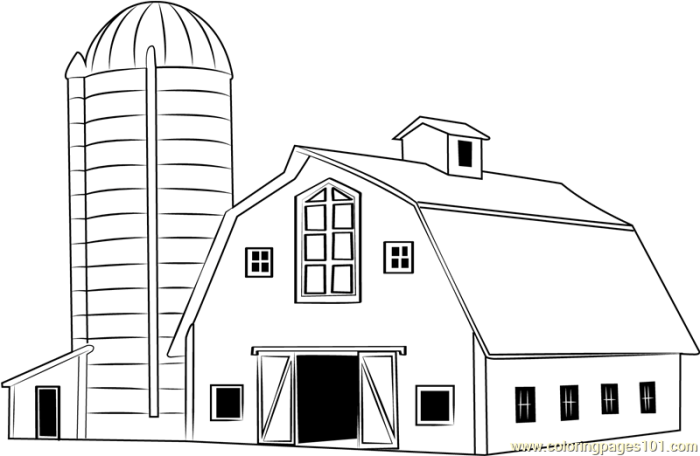
Adding details and textures significantly enhances the visual appeal and complexity of your barn coloring pages, transforming simple Artikels into engaging works of art. By incorporating realistic elements and varied textural effects, you can create coloring pages that are both fun and challenging for users of all ages and skill levels. This section will explore techniques for adding detail and texture to barn coloring pages, focusing on specific elements and coloring methods.Adding details like wood grain, hay bales, and fences brings realism to the barn.
Wood grain can be suggested through carefully placed lines following the direction of the wood planks, varying the line thickness and spacing to create a natural look. Hay bales can be represented by using short, textured strokes to imply the roughness and volume of the hay, possibly adding shading to create depth. Fences can be detailed by showing individual fence posts and rails, using varied line weights to suggest three-dimensionality.
Consider the overall perspective and lighting to enhance the realism of these details.
Texture Techniques in Barn Coloring Pages
Several techniques can be used to add texture to a barn coloring page. Cross-hatching, a technique of using intersecting lines to create shading and texture, is effective for showing the roughness of wood or the density of a hay bale. Stippling, which involves using small dots to create shading and texture, is excellent for showing the varied textures of wood, stone, or even the rough surface of a dirt road near the barn.
Other techniques include using varying line weights to suggest depth and form, or using a combination of lines and dots to create a more complex texture.
Example of Barn Coloring Page Section with Texture Techniques
Imagine a section of a barn coloring page depicting a portion of a wooden barn wall and a nearby hay bale. The wooden wall is rendered using cross-hatching. Closely spaced, parallel lines run vertically along the planks, mimicking the direction of the wood grain. Thicker lines are used to represent the shadows between the planks, adding depth and dimension.
The hay bale is depicted using stippling. Dense clusters of small dots create darker areas, suggesting the shadowed sides of the bale, while lighter, more sparsely distributed dots represent the areas where light hits the hay. The contrast between the cross-hatching and stippling techniques effectively showcases different textures within the scene, creating a visually interesting and engaging section for coloring.
The fence posts could be rendered with thicker lines, suggesting their solidity, while the rails could be depicted with thinner lines, creating a visual contrast and emphasizing the three-dimensional nature of the fence. Adding slight shading to both the posts and rails would further enhance this effect.

